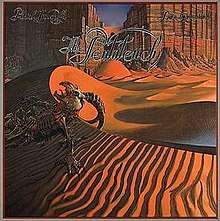The Pentateuch of the Cosmogony
The Pentateuch of the Cosmogony is a concept album and multimedia project by Patrick Woodroffe and Dave Greenslade, released in 1979. The project combines a hardback book (conceived, written and illustrated by Woodroffe) and a double vinyl album of music (written and performed by Greenslade). The title means, approximately, 'the first five books (pentateuch) of the creation (cosmogony)'. Woodroffe's artwork is heavily inspired by The Garden of Earthly Delights by Hieronymus Bosch.[1]
| The Pentateuch of the Cosmogony | ||||
|---|---|---|---|---|
 | ||||
| Studio album by | ||||
| Released | 1979 | |||
| Genre | Progressive rock | |||
| Length | 77:59 | |||
| Label | EMI | |||
| Producer | Robin Lumley, Patrick Woodroffe | |||
| Dave Greenslade chronology | ||||
| ||||
The story and artwork within 'Pentateuch' are framed as a document discovered within an abandoned spacecraft in orbit around Jupiter. As such, both the plot and prose follow the conventions of religious lore, even as it incorporates science fiction elements such as apocalyptic environmental disaster and interstellar travel in its second half. A combinatorial ideographic script is used throughout the artwork.
Greenslade contributed the 74 minutes of music as his second solo project. Like the story and artwork, the music is framed as the work of the alien race which built the spacecraft. To maintain this image of otherworldly origin, it was recorded almost entirely with electronic musical instruments.
A CD reissue was released in 1994, transferring Woodroffe's 12" x 12" book into a 5" square booklet. In order to keep the double album within the constraints of a single CD, the end of one track is faded out early.
The story was retold without music in Woodroffe's 1987 book The Second Earth. This featured additional artwork and was rewritten with extended prose replacing the original verse form. The additional artwork is not always as closely linked to the story as the original selection. A Japanese edition was also published.
Track listing
All songs written by Dave Greenslade.
- Side 1
- "Introit" – 4:05
- "Moondance" – 3:09 (CD version – original LP version is longer)
- "Beltempest" – 2.:41
- "Glass" – 3:02
- "Three Brides" – 5:56
- Side 2
- "Birds & Bats & Dragonflies" – 3:48
- "Nursery Hymn" – 3:32
- "The Minstrel" – 2:42
- "Fresco/Kashrinn" – 2:24
- "Barcarole" – 3:51
- "Dry Land" – 3:54
- Side 3
- "Forest Kingdom" – 3:53
- "Vivat Regina" – 3:44
- "Scream but Not Heard" – 2:57
- "Mischief" – 5:36
- "War" – 3:06
- Side 4
- "Lament for the Sea" – 3:08
- "Miasma Generator" – 5.23
- "Exile" – 2.33
- "Jubilate" – 3.00
- "The Tiger and the Dove" – 5.35
Personnel
- Dave Greenslade - keyboards; vibraphone; tubular bells; vocals on 10, 11, 13, and 19; vocoder (used with all vocals on album)
- Phil Collins - percussion on 5, 10, 12, 16-18
- John Lingwood - percussion on 6, 8, 15, and 16
- Kate Greenslade (age 2 years and 6 months) - vocal on 7